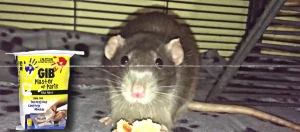Rats can be quite a nuisance—they take refuge in hidden places such as walls, basements, and dark corners of closets and drawers. At night, they become active and steal food from pantries and cupboards, leaving behind vast quantities of feces loaded with pathogens as a mark of their presence. If you don’t fancy their presence, you want them in the most effective manner possible. You need the right type of poison, and if you have plaster of Paris, that can be the solution you need. This guide helps you get rid of rats with plaster of Paris which is known to be deadly to rats if ingested.
Plaster of Paris is even considered less toxic compared to traditional rat poison, so it’s a promising solution.
How to get rid of rats with plaster of Paris

Follow these steps to get rid of rats with plaster of Paris:
1. Identify rats hideouts
First, you need to find out where rats are most likely to be. This could be close to places to get food, like the kitchen or pantry, or close to places to stay safe, like attics or crawl spaces. Once you know where they are, you can use plaster of Paris to set up bait points.
2. Create plaster of Paris rat poison
To create the bait station:
- combine a small amount of plaster of Paris with water to make a paste.
- Add a small amount of rat food to the paste, such as peanut butter or cheese.
Also, you should wear gloves when handling the mixture
3. Place the bait in rat location
Form the mixture into small balls and put them in places where rats are known to be.
The plaster of Paris bait will draw the rats, who will then eat the mixture, which will harden inside their stomachs and kill them.
Plaster of Paris can be dangerous to breathe in, so be careful when handling it. Also, make sure to keep the bait stations out of reach of children and pets so they don’t eat them by mistake.
4. Check the baits regularly
Check the bait stations often and change the ones that have been eaten. You can get rid of rats with plaster of Paris if you are persistent and patient.
What happens when a rat eats plaster of Paris?
When a rat ingests the bait, the plaster enters its digestive system and starts to harden, leading to abdominal discomfort.
Rats are unable to vomit, so they will likely attempt to relieve the pain by drinking water, particularly if you use chocolate or peanut butter as bait. This only exacerbates the situation, and the rat typically dies within a span of 2 to 4 hours after consuming the bait.
Only use small portions of the plaster of Paris bait that are appropriate for the rat population, and place it in areas that are inaccessible to pets and children.
Consider where the rats will die and begin decomposing. If they have clear paths of entry and exit, they are less likely to die behind the walls. Therefore, seal the walls until the rat population has been reduced to a point where baiting can be discontinued.
Downside of plaster of Paris
The term “Rat Balls” refers to a well-known method of using plaster of Paris as bait for rats. The concept involves mixing plaster of Paris with equal parts of corn meal, flour, or any other type of granular food.
This mixture is then moistened to form a dough-like consistency and shaped into balls. These balls are then scattered around the home to lure rats to consume them, resulting in fatal constipation. However, this method has a significant drawback. The problem with this recipe is the use of water.
Once the plaster of Paris comes into contact with water, it starts to solidify, which is not ideal as the rat needs to consume the bait while it’s still moist.
Rats have selective eating habits and are unlikely to consume much of the solidified mixture. Even if they do manage to ingest some of it, the small amount of plaster is likely to pass through their system without causing any harm.
Plaster of Paris recipes for rats
The key component in plaster of Paris is calcined gypsum (roasted gypsum), which is a tasteless and odorless powder. Rats won’t consume it on their own, but when mixed with a food item they will eat, they may not detect its presence and are more likely to ingest a lethal dose. However, the bait must be dry to ensure that the plaster remains active when the rat consumes it.
Here are some recipe options to consider to get rid of rats with plaster of Paris:
a. Mincemeat
Mix 1/2 cup of dried mincemeat with an equal amount of plaster of Paris in a bowl and place it for the rat to discover.
b. Flour and sugar
Mix 1 part flour and 1 part sugar with 2 parts plaster of Paris to create a rat solution.
c. Ground nuts
Rats have a fondness for nuts and the scent attracts them. Grind 1/2 cup of nuts into a powder and blend it with 1/2 cup of plaster of Paris.
d. Powdered chocolate
The aroma of chocolate is even stronger than nuts, and rats find it irresistible, particularly if it has sugar. Mix 5 tablespoons of powdered chocolate with 8 tablespoons of plaster of Paris in a container to use to get rid of rats with plaster of Paris.
e. Peanut butter
Combine equal parts of inexpensive peanut butter and plaster of Paris to create the mixture. Peanut butter does not contain water, so it will not activate the plaster. If you use expired peanut butter, you can even form the bait into balls that will be effective in attracting rats.
Read also: baking soda rat poison





